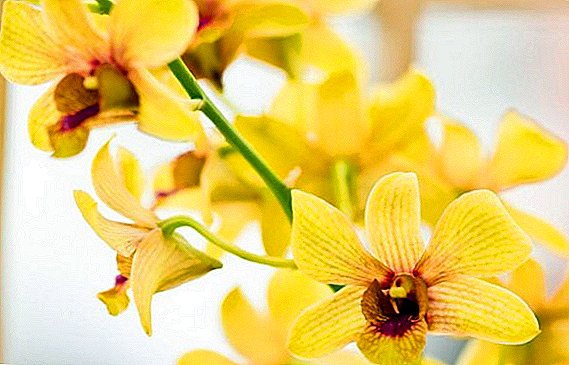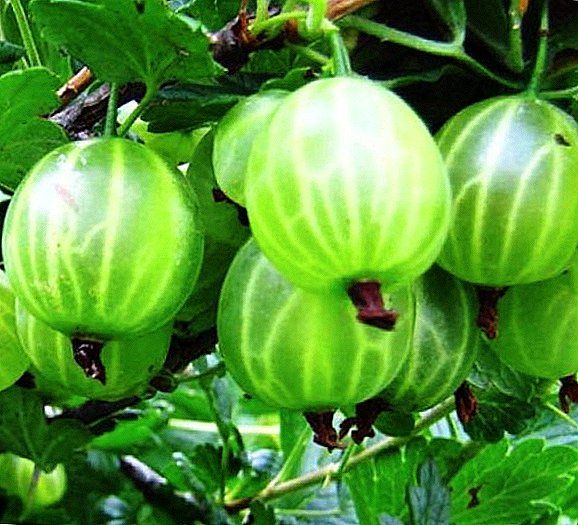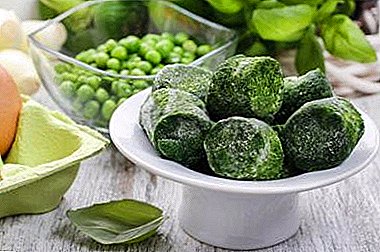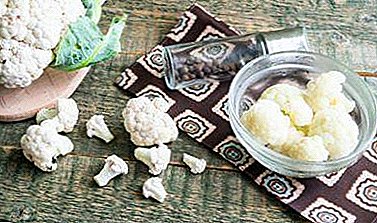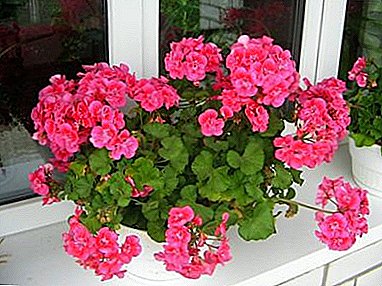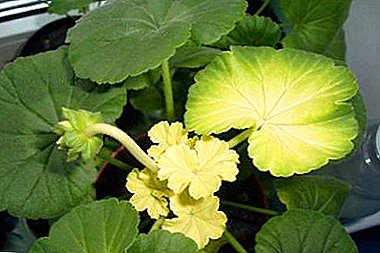
Dieffenbachia - Bright decorative evergreen plant comes from countries with a tropical climate.
Dieffenbachia common in South America, is found in North America.
Dieffenbachia: a general description of the plant
In many species of dieffenbachia large, oval-shaped leaves, growing alternately. Coloring of leaves is replete with spots, patches and patterns. It is thanks to leaves Dieffenbachia so valued by growers and grown for about 150 years.
Dieffenbachy has fleshy, robust stems, prone to tillering. Dieffenbachia of many species is a tree; part of the trunk is bare.
Although indoor plants bloom very rarely, it happens in April - early May. Inflorescence in Dieffenbachia in the form of a cob, covered with a cream-green petal-spathe. Plants bloom only a few days, a faded flower can stay on the stem for a long time.
Dieffenbachia fruits, fruits - it's orange or red berries. Strong Dieffenbachia varieties reach a height of 2 m by 5 years, sometimes more.
Important! Dieffenbachy juice is poisonous. Keep the plant away from children and animals, getting milk on the mucous membranes of the mouth will cause swelling of the larynx and tongue, and if it gets in your eyes, blindness. Take care of dieffenbachia in gloves!
How to share dieffenbachia form
The main differences between the species in the form of leaves, color and patterns on the leaf plates. Depending on the shape of the plant is divided into tree and shrubs.
Have tree Dieffenbachia varieties are a strong, thick trunk, usually without branches. The trunk of the plant becomes bare as it grows, the leaves just fly around. An adult plant is somewhat reminiscent of the silhouette of a palm tree.
Shrub Dieffenbachia is not very tall, they have branched stems and many leaves. The leaves begin to grow almost at the very base of the trunk, above the soil surface. Bushes Dieffenbachia lush and dense.
Did you know? The Austrian botanist Heinrich Shott gave the plant the name of Josef Dieffenbach. The senior gardener of the Schönbrunn palace took care of the plants of the imperial botanical gardens in Vienna.
Dieffenbachia Spotted
 Dieffenbachia spotty, or painted, enjoys special popularity among breeders. On the basis of the variety, many hybrids with an interesting color, shape and texture of leaves are bred. To the touch sheet plates can be smooth, have a convex pattern and roughness. The surface can be both matte and glossy.
Dieffenbachia spotty, or painted, enjoys special popularity among breeders. On the basis of the variety, many hybrids with an interesting color, shape and texture of leaves are bred. To the touch sheet plates can be smooth, have a convex pattern and roughness. The surface can be both matte and glossy.
Potted Dieffenbachia flowers are distinguished by their growth and development. The plant quickly grows the crown, during the year the stem grows 40 cm in height. However, reaching a height of a little over a meter, stops growing.
Dieffenbachia Motley
 Dieffenbachia motley - fast-growing plant variety. The view reaches a height of 2 m. Beautiful large leaves reach 40 cm in length and 15 cm in width.
Dieffenbachia motley - fast-growing plant variety. The view reaches a height of 2 m. Beautiful large leaves reach 40 cm in length and 15 cm in width.
Oval sheet plate of juicy green color. The pattern on the leaf plates is represented by a combination of clear white stripes and irregular-shaped spots. Dieffenbachia Motley needs diffused light. The best content will be at a distance of 2 m from the window.
Diffenbachia charming
 Variety Dieffenbachia is very enduring: not afraid of darkness and hot conditions.
Variety Dieffenbachia is very enduring: not afraid of darkness and hot conditions.
Diffenbachia charming or pleasant - this is a tree type of plant. A large number of bright green leaves with light stripes grows on the stem of one and a half meters. This species is susceptible to the invasion of spider mites, take this into account when growing.
Dieffenbachia leopold
 Dieffenbachia leopold originally from Costa Rica. A dwarf plant with a stem up to 5 cm in height and about 2 cm in diameter has dark green leaves, separated by a white central vein.
Dieffenbachia leopold originally from Costa Rica. A dwarf plant with a stem up to 5 cm in height and about 2 cm in diameter has dark green leaves, separated by a white central vein.
Sheet plate in the form of an ellipse up to 35 cm long and up to 15 cm wide. The leaves have short petioles, pale, with a lilac shade. The inflorescence in the form of a cob no more than 9 cm, covered with a white blanket 17 cm long.
Dieffenbachia Oersted
 Dieffenbachia Oersted - bush plants. They have a thick, strong, branched stem. Leaves up to 35 cm long have the shape of an ellipse, in some species the leaves are oblong or heart-shaped.
Dieffenbachia Oersted - bush plants. They have a thick, strong, branched stem. Leaves up to 35 cm long have the shape of an ellipse, in some species the leaves are oblong or heart-shaped.
Most often the leaves are juicy-green, but they are darker and with a silvery sheen. Through the entire leaf plate passes a bright strip. Dieffenbachia Oersted needs to be transplanted once every 2 years and make a rejuvenating haircut. The leaves of the plant like spraying.
Important! Dieffenbachia Oersted loves illuminated places, but does not tolerate direct sun as much as full shadow. It is extremely undesirable for her drafts and temperatures below 14-15 ° C.
Dieffenbachia Reflector
 Dieffenbachia Reflector in nature prefers rainforest. This plant loves moisture, frequent watering, it does not interfere with direct sunlight. Draft and low temperatures for Reflector are disastrous.
Dieffenbachia Reflector in nature prefers rainforest. This plant loves moisture, frequent watering, it does not interfere with direct sunlight. Draft and low temperatures for Reflector are disastrous.
The plant has an interesting "camouflage" color. On the sheet plate on a dark green background, either light green or yellow round spots are scattered. Along the sheet passes a clear white stripe.
Dieffenbachia bauze
 Adult height dieffenbachia bauze reaches 90 cm. The marble pattern on the leaves is yellow and white irregular-shaped stains. Sheet length up to 30 cm.
Adult height dieffenbachia bauze reaches 90 cm. The marble pattern on the leaves is yellow and white irregular-shaped stains. Sheet length up to 30 cm.
This variety rarely blooms, a cop in the form of a cob with small flowers. Bauze is contraindicated in dark rooms, in the shade its leaves will lose their decorative coloration and wither. The plant needs transplants once every 2 years, regular watering and temperatures not lower than 12 ° C.
Dieffenbachia Baumann
 Sort Baumann has an unusual structure: large leaves on long petioles-stems grow from a thick stem.
Sort Baumann has an unusual structure: large leaves on long petioles-stems grow from a thick stem.
Leaves of light green color are covered with specks of various form and size. There are species with a yellowish, almost cream pattern on the sheet plate.
The leaves have a lot of bright spots and round or oval-shaped spots. Sheet length up to 75 cm.
Dieffenbachia Barakven

This variety was attributed to the spotted dieffenbachia, until it was isolated into a separate one.
Dieffenbachia Barakven differs from the spotty by a greater saturation of white patches and a white central stripe that separates the sheet plate along.
It is noteworthy that the stem of the plant is also almost white.
Interesting! The history of the plant is overshadowed by one unpleasant fact. At the time of slavery, the diefenbachia stalks punished slaves by using rods instead of rods. Juice falling into wounds caused swelling and burns.
Dieffenbachia large-leaved
 Large-leaved dieffenbachia - guest from Peru. She has a strong thick stem in a meter tall. On the stem is a luxuriant mass of leaves up to 60 cm long and 40 cm wide.
Large-leaved dieffenbachia - guest from Peru. She has a strong thick stem in a meter tall. On the stem is a luxuriant mass of leaves up to 60 cm long and 40 cm wide.
The leaves are oval-shaped, painted in a very dark green color. The leaf veinlets are much lighter than the general background; the central strip is especially prominent. When growing plants need moderate watering and heat. The disadvantage of this type in a sharp unpleasant smell.
Dieffenbachia Camilla
 Sort Camilla come from the tropics of South America. "Camilla" grows up to 2 m. She has a strong stem with oblong large leaves. The leaves are white closer to the middle, on the edge - green. With age, white spots disappear from the leaf.
Sort Camilla come from the tropics of South America. "Camilla" grows up to 2 m. She has a strong stem with oblong large leaves. The leaves are white closer to the middle, on the edge - green. With age, white spots disappear from the leaf.
"Camilla" is developing rapidly, within a week a new leaf grows. Flowering plant in spring. There are species with a yellowish center on a dark green background. The best place for it will be a shaded corner in a ventilated room without drafts.
Dieffenbachia plant has many species and names, but all of them are united by rapid growth and leaf splendor. They are often used to decorate offices, conservatories, greenhouses and public buildings.



